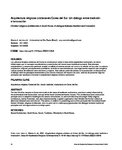Arquitectura religiosa cristiana en Corea del Sur: un diálogo entre tradición e innovación

View/
Use this link to cite
http://hdl.handle.net/2183/32463
Except where otherwise noted, this item's license is described as https://creativecommons.org/licenses/by-nc/4.0
Collections
Metadata
Show full item recordTitle
Arquitectura religiosa cristiana en Corea del Sur: un diálogo entre tradición e innovaciónAlternative Title(s)
Christian religious architecture in South Korea. A dialogue between tradition and innovationAuthor(s)
Date
2022-12-28Citation
Marcio A. de. 2022. «Arquitectura religiosa cristiana en Corea del Sur. Un diálogo entre tradición e innovación». Actas de Arquitectura Religiosa Contemporánea 9: 40-55. https://doi.org/10.17979/aarc.2022.9.0.9346.
Abstract
[Resumen] Los primeros templos cristianos de Corea se construyeron sobre la base de la arquitectura tradicional y se vieron influenciados por el concepto arquitectónico y constructivo del hanok (casa tradicional coreana). Este principio arquitectónico y constructivo pretende adaptar el edificio al entorno natural, así como a la entrada de luz solar. La primera
arquitectura religiosa, principalmente protestante, también se caracterizaba por una organización espacial que recogía la
cultura coreana de distinción entre hombres y mujeres. Este artículo pretende señalar en la producción contemporánea el diálogo entre los principios tradicionales y los nuevos enfoques del espacio de culto, además de presentar algunos principios que ayudaron a formular la arquitectura religiosa cristiana surcoreana. [Abstract] The first Christian temples in Korea were built on the basis of traditional architecture, and were mainly influenced by the architectural and construction concept of the 'hanok' (traditional Korean house). This architectural and construction principle aims to adapt the building to the natural environment, as well as to the entry of sunlight. Early religious architecture, mainly Protestant, was also characterized by a spatial organization that reflected the Korean culture of distinction between men and women. This article, in addition to presenting some of the principles that formulated South Korean Christian religious architecture, aims to point out in contemporary production the dialogue between traditional principles and new approaches to worship space.
Keywords
Arquitectura religiosa
Corea del Sur
Hanok
Tradición
Cristianismo en Corea del Sur
Sacred architecture
South Korea
Tradiction
Christianity in South Korea
Corea del Sur
Hanok
Tradición
Cristianismo en Corea del Sur
Sacred architecture
South Korea
Tradiction
Christianity in South Korea
Editor version
ISSN
2659-8671






